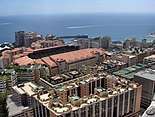Stade Louis II
The Stade Louis II (French pronunciation: [stad(ə) lwi dø]) is a stadium located in the Fontvieille district of Monaco. It serves primarily as a venue for football, being the home of AS Monaco and the Monaco national football team. The stadium is most notable for its distinctive nine arches at the away end of the ground.[2] The arena is also used for the Herculis, a track and field meet of the Diamond League. From 1998 to 2012, the stadium hosted the annual UEFA Super Cup match.[3]
 UEFA | |

| |
| Location | 7, avenue des Castelans 98000 Fontvieille, Monaco |
|---|---|
| Coordinates | 43°43′39″N 7°24′56″E |
| Owner | Monaco |
| Operator | Monaco |
| Capacity | 16,360[1] |
| Record attendance | 20,000 (AS Monaco vs U.C. Sampdoria, 3 April 1990) |
| Field size | 105 × 68 metres (344 ft × 223 ft) |
| Surface | GrassMaster by Tarkett Sports |
| Construction | |
| Built | May 1981 (current) |
| Opened | 1939 (original) 25 January 1985 (current) |
| Architect | Henri Pottier, Philippe Godin, Jacques Rechsteiner, Rainier Boisson, Joseph Iori |
| Tenants | |
| AS Monaco Monaco national football team | |
| Website | |
| Official Website | |
History
The original Stade Louis II was opened in 1939 as the home of AS Monaco. The decision to build a new sports centre in Monaco dates back to 1979. Prince Rainier III decided to establish a sports area in the Fontvieille district. The prince brought in Parisian architects to build the complex. The work began in May 1981 and ended in 1984, and required 120,000 m3 of concrete, 9,000 tonnes of iron and 2,000 tonnes of steel structure on a median land reclaimed from the sea. The complex was inaugurated on 25 January 1985 by Rainier III.
The stadium has a current seating capacity of 16,360, and is named after Louis II, Prince of Monaco, who was the Sovereign Prince of Monaco when the original stadium was built. The vast majority of the stadium's facilities are located underground, including the multi-sports centre Gaston-Medecin, the aquatic centre Prince Albert II and a large car park directly under the pitch.
Facilities
The Salle Gaston Médecin indoor arena is located under the stands of the football stadium. Salle Gaston Médecin is able to host basketball, volleyball, and handball games, as well as judo and fencing matches, and weightlifting and gymnastics competitions.
The stadium complex, besides the football stadium and athletics track and the Salle Gaston Médecin, also contains the aquatic centre Prince Albert II, a large office complex, and also houses the International University of Monaco (IUM), which specializes in business education.
Gallery

A top view of the stadium The Salle Gaston Médecin indoor arena, which is used by the AS Monaco basketball club
See also
- Geography of Monaco
References
- "Presentation of the Stade Louis-II". AS Monaco. Retrieved 14 January 2020.
- "Monaco have plenty of money and ambition but not many supporters". The Guardian. 21 September 2013. Retrieved 9 May 2019.
- "Prague celebrates 2013 Super Cup honour". UEFA. Retrieved 14 January 2020.
External links
| Wikimedia Commons has media related to Stade Louis II. |
| Preceded by Two-legged matches |
UEFA Super Cup Match venue 1998–2012 |
Succeeded by Eden Arena Prague |